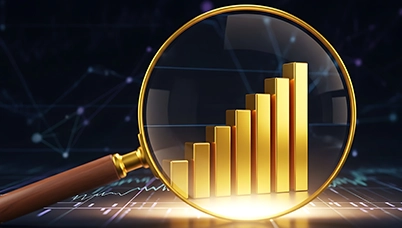Gold or Silver?
Posted On Friday, May 21, 2010
Colloquially speaking, `Gold` and `Silver` are often mentioned in the same breath - "Sona - Chaandi",
"Au-Ag"... However in terms of investment, does the Silver lining make as much sense as the Gold rush?
Following up on my previous write-up about the rising need of a "safe-haven" investment, and given the prevailing government insolvency threats, rising deficits and unsustainable debt levels, investor faith in currencies is steadily eroding. If the heightened demand for gold coins, bars and exchange traded funds is anything to go by, then there is an encouraging trend which suggests that investors are shifting to gold as an investment option.
In this entire chaos, silver has come out with returns that are in sync with those recently delivered by gold. And so, it’s quite understandable that many investors are tempted to allocate further to silver instead of gold. Our interactions with investors also show rising curiosity for silver:
"Can silver match what’s expected of gold?"
"Will silver be as good a hedge for uncertainty / inflation?"
However, the underlying question should rather be:
How good is silver as "Portfolio insurance"?
Well, let’s start with the recent crisis. The portfolio values saw steep declines as the global financial crisis aggravated in mid 2008. It was during this time when investors realized the importance of having an asset that can minimize their overall portfolio losses. In the chart below, observe the performance of gold and silver since the mid 2008 crisis intensified.
Chart: Gold, Silver and Copper since mid 2008

Source: Bloomberg
Keep looking at the chart above and you’ll be able to tell just how good a performer gold has been in difficult times, helping investors to minimize losses on other assets.
Coming to silver, in terms of price behavior, it is best described as "Half Gold, Half Copper". Silver, like gold, also has a history of being used as a currency - a medium of exchange. However the story changed after it stopped being used as a currency, when due to silver’s important metallic properties, abundant availability and lower cost, it saw a spurt in usage as an industrial commodity. 73% of silver’s overall demand is accounted for by industrial usage while the remaining 27% comes from currency, investments or jewellery purposes.
Going back to the chart above, returns from silver are more skewed towards those delivered by copper and less towards gold. Thus, silver is riding on gold’s rally but is pulled lower on account of weakness in other industrial commodities (e.g. copper).
Disappointing but true - during the recent turmoil silver failed to deliver the "hedge" quality. To present a better case, let’s consider a broader time period, when returns from equities did not meet expectations.
Table: Returns of Sensex, Gold and Silver since 1998 in years when Sensex had negative / lower
Year | Sensex | Gold INR | Silver INR |
1998 | -16% | 8% | -9% |
2000 | -21% | 1% | -8% |
2001 | -18% | 6% | 4% |
2002 | 4% | 24% | 3% |
2008 | -52% | 31% | -5% |
Spend a little time on the table above and you will be able to see that gold has been a better portfolio diversifier than silver in the years when equities have been negative or have delivered very low returns.
It is a fact that investors invest in gold because they believe in its ability to store value.
Let’s come back to the current scenario where policy makers are seen doling out money to solve economic worries. Earlier, we saw US bailing out banks and financial institutions by providing money and now the delinquent governments of Europe are being gifted monetary rescue packages. Amidst all this pandemonium, inflationary prospects are as sure as death and taxes.
So, does silver have the ability to protect you from inflation? Which is a better inflation hedge -
Gold or Silver?
Chart: Gold, Silver and Inflation

Source: Bloomberg
If you take a look at the chart above, gold has been a much better inflation hedge in comparison to silver over the longer time horizon. On the other hand, silver had been a laggard for most of the time (over the horizon considered). It has only recently managed to move above the inflation line.
Given the current uncertainty, and the inflationary prospects which are looming large in the medium to long term time horizon, gold looks like a much better asset to hold in one’s portfolio.
An investment in silver is, in some sense, a play on global economic growth - but your equity shares already give you that exposure to the "upside".
Gold is a better portfolio diversification play and a better hedge as it will move less in tandem with global GDP activity.
In conclusion, gold continues to be a sensible hedge for your long term portfolio against financial crisis, rising inflation, currency devaluation and declines in financial markets.
Click here to invest in the Quantum Gold Fund ETF
Disclaimer:
The views expressed in this article are the personal views of the Fund Manager of Quantum Gold Fund. The views constitute only the opinions and do not constitute any guidelines or recommendation on any course of action to be followed by the reader. This information is meant for general reading purpose only and is not meant to serve as a professional guide/investment advice for the readers. This article has been prepared on the basis of publicly available information, internally developed data and other sources believed to be reliable. Readers are advised to seek independent professional advice and arrive at an informed investment decision before making any investments. Please visit – www.quantumamc.com/disclaimer to read scheme specific risk factors.
Related Posts
-

Gold Monthly for December 2025
Posted On Thursday, Dec 04, 2025
After a series of events and a strong rally in October 2025, gold demonstrated a mixed performance in November 2025, moving back and forth within a defined range.
Read More -

Equity Monthly for December 2025
Posted On Wednesday, Dec 03, 2025
Markets continued the rising trend in October with Sensex gaining 2.2%.
Read More -

Debt Monthly for December 2025
Posted On Tuesday, Dec 02, 2025
As we approach the end of the calendar year, we find ourselves at a pivotal moment, with the market split on the likelihood of an upcoming rate cut.
Read More



